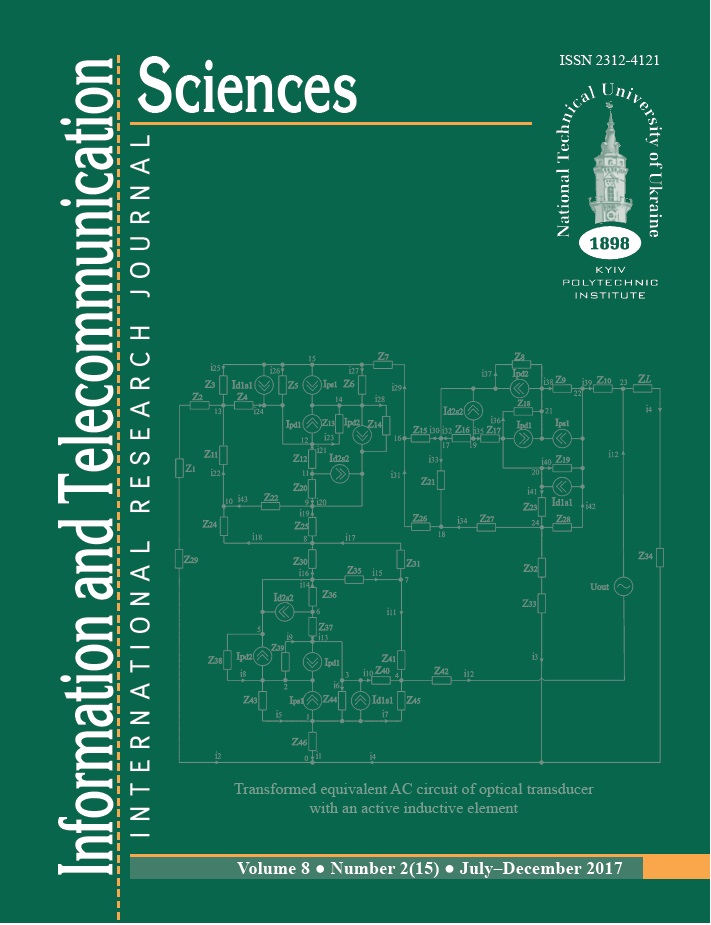EVALUATION OF FREQUENCY RESOURCES OF FOCL WITH THE USE OF NEW TECHNOLOGIES
DOI:
https://doi.org/10.20535/2411-2976.22017.32-37Keywords:
optical channel, transmission rate, error rate, optical soliton interchannel effect, spectral widthAbstract
Background. Currently, communication networks are under development of high-speed transmission technology for single channel fiber optic transmission systems, along with intensive introduction of Wavelength Division Multiplexing
technology. Thus there are variants of optical channels design with different transmission rate, which may differ by an order or more, e.g., in the STM-16 standard, it is 2.5 Gbit / s, and STM-256 standard - 40 Gbit / s. Thus, issues arise with respect to the comparison of frequency resource in various transmission technologies that provide certain information bandwidth.
Objective. The aim of the paper is to find solutions that can increase information throughput of FOCL at constant frequency resource.
Methods. FOCL analysis with frequency multiplexing showed the feasibility of a smaller number of channels but with a higher data rate in each channel. In addition, a perspective use of soliton transmission mode to increase capacity is shown.
Results. It was shown that to improve the wavelength division information-bandwidth transmission system in a fixed wavelength band it is plactical to use a minimum number of optical channels while increasing the transmission rate in each of them.
Conclusions. The possibility to improve information throughput by increasing the number of channels limited by the transmission band of the optical amplifiers. A considerable part of the frequency resource is used for intervals between the optical channels in order to maintain the requirements for inter-channel effect and consideration of the laser frequency instability and its spectral linewidth. Thus, there is a certain margin for further increase of FOCL throughput. This can be achieved by increasing the transmission speed in each optical channel while reducing their number.
Keywords: optical channel; transmission rate; error rate; optical soliton interchannel effect; spectral width.
References
Roger L. Freeman. Fiber-Optic Systems for Telecommunications,
, 416 p.
S. Dmitriev, N. Slepov. Fiber-optic apparatus: modern trends and
prospects. 2nd Vol., “Fiber-optic apparatus”, 2005, 576 p
N. Slepov. Modern technologies of digital fiber optic communication
networks, 2nd Vol., 2003, 468 p.
ITU-T Recommendation G.694.1 (06/02) Spectral grids for WDM
applications: DWDM frequency grid.
W. Tomasi. Electronic Communications System, 2007, 1360 p.
ITU-T Recommendation G.663 Application Related Aspects of Optical
Fiber Amplifier Devices and Subsystem
S. Li. Semiconductor Physical Electronics. 2nd Edition. Springer, 2006.
p.
Yamamoto T., Tamura KR 1,28 Tbit/c – 70 km OTDM transmission
with a phase third and fourth-order simultaneously dispersion
compensation with a phase modulation. Electronics Letters. 2000, vol.
, #24, pp. 2027-2028.
G. Agraval. Non-linear fiber optics, 1996, 324 p.
O. Sklyarov. Fiber-optic networks and communication systems. 2nd
Vol., 2010, 272 p.

